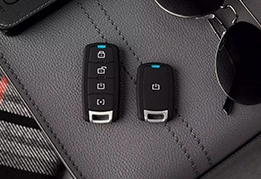What is data-link?
Data-link is a high speed data communication link used between more than one after-market electronic device. These devices include remote-starters, alarm systems, GPS and telematics devices, and immobilizer bypass or interface module(s). The data-link protocol uses the EIA (Electronic Industries Association) RS-232 serial connection and communication standard. This is the exact same communication standard used with USB, which allows various electronic devices to communicate with each other. In our case, it allows the remote-starter or alarm-system and the immobilizer bypass or interface module(s) to share a variety of different information.
What benefits are there when using data-link?
Using the data-link port to link communication between the after-market remote-starter or alarm-system and an immobilizer bypass or interface module reduces the amount of wiring required in 2 ways. First it reduces the amount of redundant wiring required for both devices. Instead of having to manually connect an ignition wire to both devices, using the data-link port will only require you to connect the ignition wire to one device, which will share the ignition status (ON/OFF) through the data-link port to the other connected device(s). Secondly it reduces the amount of wiring by not requiring analog connections in a networked vehicle. Many of the vehicles functions can be read by receiving and controlled by sending data on the vehicles data-bus (eg J1850, CAN, etc.). Our immobilizer bypass and interface modules offer control over a variety of different functions on thousands of different vehicles and can send and receive data on the vehicles data-bus through instructions from the data-link port. This normalizes the communication and allows an after-market remote-starter or alarm-system to send and receive data from the vehicle without having to manually connect an analog wire to the vehicle for every possible function.
Reducing the amount of wiring required for the installation not only simplifies the installation and saves time, but it also reduces the chances of installation error and fewer possible points of failure due to cold solder joints and corrosion.
What is the difference between 1-way and 2-way data-link?
The 1-way data-link port allows a remote-starter or alarm-system to send commands to an immobilizer bypass or interface module. This includes such commands as GWR status, door-lock, door-unlock and much more. The 2-way data-link is an extension to the 1-way data-link protocol by allowing the module to send numerous different statuses from the vehicle back to the remote-starter or alarm-system. This includes such statuses as door-pin, hood-pin, tachometer RPM and much more.
What Fortin products support data-link?
All of our data modules support data-link. All of these modules are listed in the "Affected Products" list at the top of this page. You can also manually check the features section of any of our products to determine if the module supports the 1-way protocol, 2-way protocol, or both.
Does data-link work with DEI's D2D or DBI?
Data-Link is the protocol that works all after market remote starters and alarm systems. Moreover, we include all necessary conexions to these products. Therefore, Data-Link is compatible with D2D, DEI and DBI protocols.
What remote-starter and alarm-systems support data-link? More brands of remote-starters and alarm-systems currently support our data-link protocol than any other similar protocol. Click here to view a current list of compatible brands.
Is data-link extensible?
Absolutely. The protocol has been extended numerous times to include various new features and functionality and there is still plenty of room for future enhancements as we continue to release new products and firmware with features that simplify after-market installation.
Why does my module have more than one data-link port?
Some of our immobilizer bypass and interface modules have more than one data-link port in order to allow you to use more than one module on the data-link bus by daisy-chaining them together. Although chaining together multiple devices in this manner appears to be in series, the data-link bus is in fact a parallel network, so you can achieve the same result by splicing into a data-link cable and create a T-harness with more than one cable.
What if my remote-starter or alarm-system does not support data-link?
All of our data-link modules can still be wired manually if the remote-starter or alarm-system you are installing it with does not support data-link. Every immobilizer bypass and interface module can be wired manually so it remains compatible with all brands of after-market remote-starters and alarm systems. However, since some of modules support more functions than there are wires available on its plugs, some of the less common features may only be available through data-link. When this is the case we try to make the most common features available on the plug as a wired input or output to offer the broadest range of support.
How do I troubleshoot a problem with data-link?
Since the data-link port handles most of the signals that a wired input or output would traditionally handle, it becomes difficult to troubleshoot the communication between the devices when a problem occurs. Because of this we provide the TEST-LINK 2-way data-link tester. It has 2 data-link ports and connects between the remote-starter or alarm-system and the immobilizer bypass or interface module. It allows the installer to verify 7 different input commands (Foot Brake, Tach, Overrev, Hood, Door, Trunk, Hand Brake) and has a button which sends a LOCK output.

 EVO-4-SERIES
EVO-4-SERIES
 EVO-9-SERIES
EVO-9-SERIES
 EVO-START
EVO-START
 FlashLink Mobile
FlashLink Mobile
 Audi
Audi
 Buick
Buick
 Cadillac
Cadillac
 Chevrolet
Chevrolet
 Ford
Ford
 GMC
GMC
 Hyundai
Hyundai
 Kia
Kia
 Mazda
Mazda
 RAM
RAM
 Subaru
Subaru
 Toyota
Toyota
 Volkswagen
Volkswagen

 Find Our Products
Find Our Products  Order Our Products Online
Order Our Products Online
 Find an
Find an 

